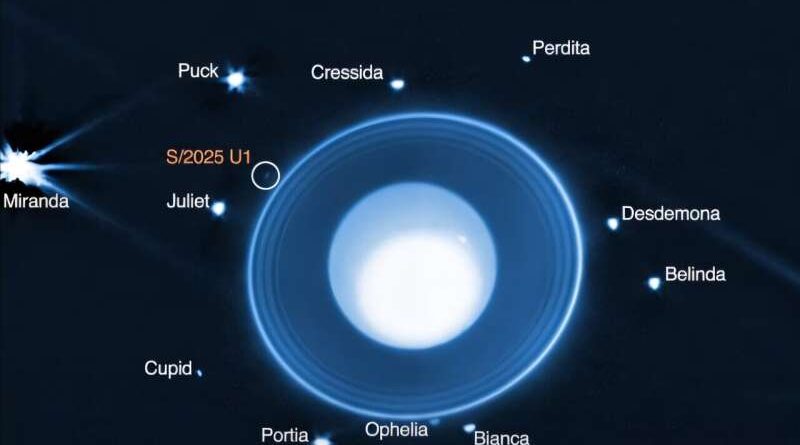New Uranus Moon Discovered: 29th Satellite Found by Webb Space Telescope
The cosmos continues to surprise us with its hidden secrets. The latest breakthrough comes with the announcement that a new Uranus moon discovered by NASA’s James Webb Space Telescope has expanded our understanding of the ice giant’s complex satellite system. This remarkable finding, announced in August 2025, marks a significant milestone as the new Uranus moon discovered brings the planet’s total satellite count to an impressive 29 moons.
How the New Uranus Moon Discovered Changed Our Understanding
The new Uranus moon discovered by the team was made using Webb’s Near-Infrared Camera (NIRCam), with the team detecting this elusive celestial body during observations conducted on February 2, 2025. The process behind how this new Uranus moon discovered came to light involved analyzing a series of ten 40-minute long-exposure images, demonstrating both the telescope’s sensitivity and the meticulous work required for such discoveries.
What makes this new Uranus moon discovered particularly remarkable is its diminutive size. At just six miles (10 kilometers) in diameter, this newly found satellite represents one of the smallest moons in our solar system. The characteristics of the new Uranus moon discovered help explain why it remained hidden for so long.
Why This New Uranus Moon Discovered Remained Hidden Until Now
The small size of the new Uranus moon discovered explains why it remained undetected for nearly four decades since Voyager 2’s historic flyby. This new Uranus moon discovered showcases how advanced Webb’s technology has become compared to earlier space missions. The fact that this new Uranus moon discovered remained invisible to Voyager 2 demonstrates the remarkable leap in our astronomical detection capabilities.
This discovery highlights how far astronomical technology has advanced. What remained invisible to one of humanity’s most successful planetary exploration missions is now detectable from over a billion miles away, showcasing the revolutionary capabilities of the James Webb Space Telescope.
Orbital Characteristics of the New Uranus Moon Discovered
The new Uranus moon discovered joins an intricate system of small inner moons that orbit closer to Uranus than the planet’s five major satellites. This new Uranus moon discovered becomes the 14th member of the complex inner satellite system, positioned approximately 35,000 miles (56,000 kilometers) from Uranus’s center.
The location where the new Uranus moon discovered orbits is particularly interesting to scientists. Nestled between the orbits of Ophelia and Bianca, the new Uranus moon discovered follows a nearly circular orbital path within the planet’s equatorial plane. This orbital characteristic of the new Uranus moon discovered suggests it may have formed near its current location rather than being captured from elsewhere.
Scientific Significance of the New Uranus Moon Discovered
The new Uranus moon discovered has important implications for planetary science. Research team member Matthew Tiscareno noted that the new Uranus moon discovered adds to Uranus’s distinction as having more small inner moons than any other planet in our solar system. The discovery of this new Uranus moon discovered creates even more complex gravitational interactions within the system.
Since the new Uranus moon discovered is smaller and fainter than previously known inner moons, scientists believe more small satellites await discovery. The characteristics of the new Uranus moon discovered suggest that Uranus’s inner region harbors additional complexity that will reshape our understanding of planetary system evolution.
Technology Behind Finding the New Uranus Moon Discovered
The success in identifying this new Uranus moon discovered exemplifies Webb’s revolutionary impact on solar system exploration. The detection process that led to the new Uranus moon discovered was made possible through Webb’s General Observer program, demonstrating how the new Uranus moon discovered represents a breakthrough in our observational capabilities.
NIRCam’s exceptional sensitivity enabled the team to spot the new Uranus moon discovered from over a billion miles away. The infrared capabilities that allowed the new Uranus moon discovered to be detected show how Webb can identify objects that remained invisible to previous telescopes.
Future Implications of the New Uranus Moon Discovered
The new Uranus moon discovered represents far more than simply adding another satellite to Uranus’s count. This new Uranus moon discovered demonstrates how modern astronomy builds upon previous missions while pushing exploration boundaries further than ever before. The successful identification of this new Uranus moon discovered nearly four decades after Voyager 2’s flyby shows the remarkable progress in astronomical technology.
As scientists await IAU approval for naming the new Uranus moon discovered (following the tradition of Shakespearean characters), this finding reminds us that our solar system holds many more secrets. With Webb’s capabilities now proven through discoveries like this new Uranus moon discovered, we can expect additional surprising findings that will continue to reshape our understanding of distant worlds.
The new Uranus moon discovered also underscores the importance of continued investment in advanced astronomical instrumentation. Each breakthrough like this new Uranus moon discovered reveals previously hidden aspects of our cosmic neighborhood, proving that the universe always has more stories to tell. This new Uranus moon discovered marks not an ending, but the beginning of a new era of outer solar system exploration that promises to unveil the intricate details of worlds that have remained mysterious for far too long.
The research has been published in NASA

